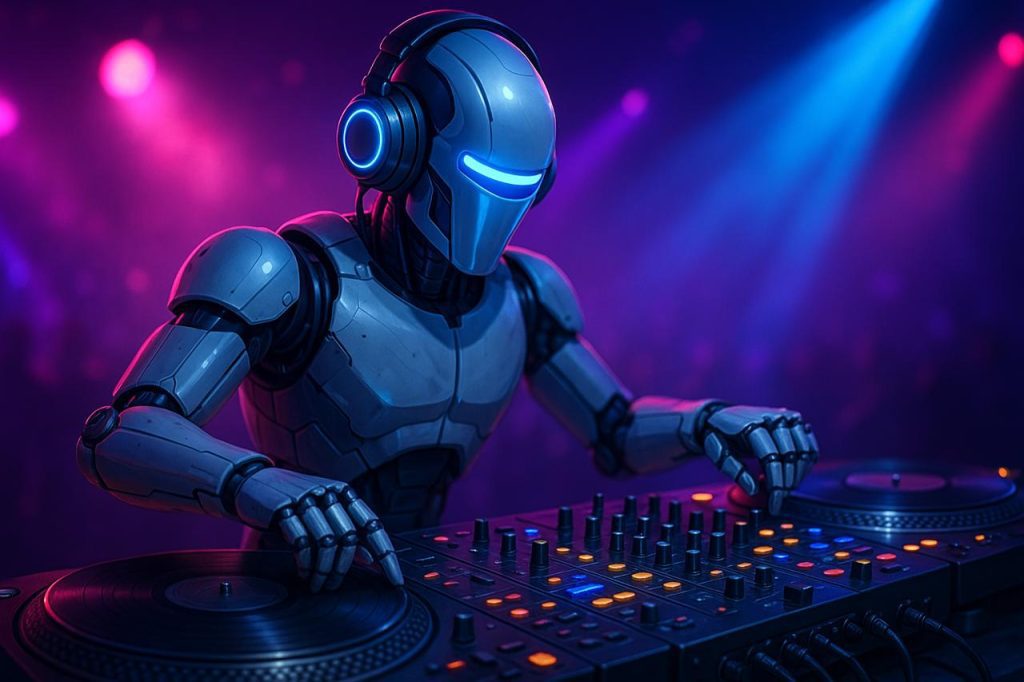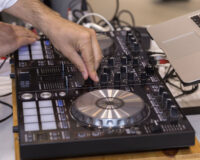

Artificial Intelligence is not new to the world of music but its integration into the DJ space is reaching a critical point. We are witnessing the emergence of a technological revolution that could redefine what it means to be a DJ. The path toward automation in the DJ booth can be broken down into three clear stages. And according to recent developments, we’re already at Stage 1 with Stages 2 and 3 advancing faster than many of us anticipated.
Stage 1: Accessing the Music Library
Until recently, DJs were limited to what they physically owned or downloaded. Now, that barrier has been erased. The integration of Apple Music with DJ software like Rekordbox and Serato gives DJs instant access to millions of tracks on-demand. This is a monumental shift. Imagine every song ever produced, from obscure B-sides to the latest chart-toppers, being available at your fingertips no crates, no hard drives, no limits.
In short, DJ software now has unlimited access to the global music archive. This marks the first step toward full automation. With the music database unlocked, the next challenge is intelligent curation.
Stage 2: Machine Learning for Seamless Mixing & Curation
This is where AI shines. Machine learning algorithms are being trained to understand BPM, key, phrasing, genre, and even mood. Tools like Mixed In Key and Beatport’s DJ AI already use smart suggestions to help DJs select the next best track. Spotify’s AI DJ feature, introduced in 2023, uses generative AI and personalization algorithms to speak and select tracks like a radio host tailored for you
What happens when this kind of algorithm enters the booth?
Imagine a system where you simply select a few criteria “Deep House, energetic, 124 BPM, peak hour” and the AI instantly builds a set that matches not just the vibe, but also audience preferences based on crowd data. Flawless beatmatching, harmonic mixing, and mood transitions? All automated.
We’re seeing the early stages now, but the momentum is undeniable. Stage 2 is rapidly approaching maturity.
Stage 3: Reading the Crowd
The final frontier is emotional intelligence reading the room. DJs aren’t just selectors; they’re crowd psychologists. They gauge mood, anticipate shifts in energy, and respond in real time. This has long been seen as the irreplaceable human touch.
But what if technology could read the crowd better than a human?
We believe this may become possible through data-driven personalization. Picture this: every ticket to an event is digital. When someone purchases a ticket, the system through opt-in permissions accesses their Spotify, Apple Music, or YouTube Music history. It analyzes genre preferences, listening habits, and even favorite drop moments.
Now scale that across thousands of ticket buyers. The system would have a complete picture of the crowd’s collective taste before the first beat drops. On the dancefloor, real-time data from motion sensors, biometric wearables (like heart rate monitors on smartwatches), and even facial recognition could inform the system about engagement levels, energy peaks, and emotional response.
It’s not far-fetched. Companies like Endlesss and Sensorium are already experimenting with immersive, AI-driven music experiences. With enough data, an AI DJ could read and react to a crowd with near-perfect precision.
The DJ’s Dilemma: Innovation or Obsolescence?
This scenario is both exciting and terrifying.
Exciting because we’re on the cusp of a new creative frontier where AI and humans can collaborate like never before. Scary because we may be just two steps away from losing the human DJ altogether.
The question is: can a machine ever replicate the emotional nuance, spontaneity, and artistic presence of a live human DJ?
Maybe not entirely. But the experience it offers could be different, not necessarily worse. In certain contexts retail stores, fitness studios, or background playlists AI might be the preferred DJ. But for underground raves, sunrise sets, and intimate venues, the human element may remain irreplaceable.
Final Thoughts
We are living through a transitional moment in music history. As we move through Stage 2 and approach Stage 3, the role of the DJ will inevitably evolve. Those who adapt, collaborate with AI, and leverage its strengths may not only survive but thrive.
But one thing is certain: the decks are being reshuffled.





4 Comments
Choosing clothes like loose-fitting shorts and simple tops fosters relaxation.
clothes that make you feel confident [url=https://granadinabm.com/blog/finding-confidence-in-summer-style/]https://granadinabm.com/blog/finding-confidence-in-summer-style/[/url]
Blockchain can revolutionize how we conduct elections. This technology provides a tamper-proof method for vote recording, enhancing election integrity.
quick cryptocurrency transfers [url=buybybitcoin.com/speed-and-simplicity-in-digital-payments]https://buybybitcoin.com/speed-and-simplicity-in-digital-payments/[/url]
This is going to be incredibly useful for my work.
Understanding the essentials of injury claims is vital for anyone engaged in an accident. This article will offer you with key insights about the steps involved in filing a claim.
family law guidance [url=http://www.johnsonbearse.com/blog/when-families-and-the-law-intersect/]https://johnsonbearse.com/blog/when-families-and-the-law-intersect/[/url]